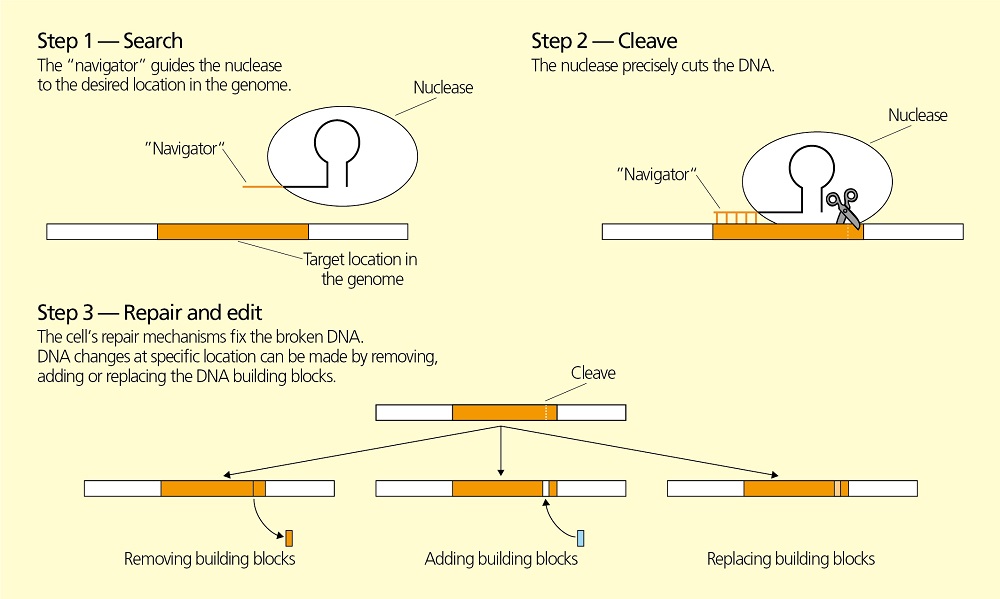Genome editing
Agriculture and animal husbandry are facing major production challenges posed by climate change and population growth. One way of improving future yields is to develop plant and animal varieties that can make better use of limited resources. To this end, a range of new breeding techniques have been developed in order to introduce new traits or modify existing ones by making specific changes to the genetic make-up of crops and livestock. Of the techniques developed, genome editing is gaining more importance.
What is genome editing?
Genome editing refers to a set of techniques which can be used to introduce specific changes to the genome of the target organism. In general, two indispensable components are needed for genome editing: a nuclease* and a “navigator”. As part of the process, the “navigator” is customised in such a way that it “identifies” the relevant location in the genome and guides the nuclease to the targeted DNA sequence (see Figure). At the specific location, the nuclease accurately cleaves the DNA and the cell naturally repair the cut.
As the DNA repair machinery is prone to error, one or a few DNA building blocks may be added to or deleted from the original gene sequence during DNA repair which renders the target gene non-functional (i.e. turning the gene off). Alternatively, scientists can alter the function or characteristics of the target protein by replacing a DNA building block or an existing DNA segment in the genome during the process.
* Nucleases are enzymes that act like molecular scissors to cut the DNA at the chosen site(s).

Figure: Schematic diagram illustrating the process of genome editing.
What are the differences between genome editing and other breeding techniques?
A number of breeding methods have been used over the centuries to develop improved crops and livestock (see Table). Conventional breeding usually makes use of crossing of closely related individuals to produce plants and animals with desirable properties. It is also possible to generate new variants with the use of chemical- or radiation-induced mutagenesis#. In these processes, however, the breeders do not know exactly where in the genome the changes have occurred. A subsequent selection process is therefore needed whereby individuals containing the desired modification are selected.
Unlike traditional plant and animal breeding, which involves multiple crosses and selection for organisms with the desired traits, genetic engineering takes the gene directly from one organism and inserts it into another. The process is much faster and can be used to insert genes from unrelated organisms. Undesired genes could also be prevented from being introduced into the target organism.
While gene insertion takes place at random sites with established genetic modification, genome editing allows precise and specific modifications in target genes. The form of modification takes at the defined location depends on how the genome editing tools are used. In some cases, the modification can be as little as a substitution of a single DNA building block. These deliberate alterations are difficult to differentiate from naturally occurring mutations on the basis of the DNA sequence. Additionally, the genome-edited organism may not contain new DNA. As a result, some foods produced using genome editing are indistinguishable from foods that have been produced using conventional methods of plant and animal breeding.
Table: Characteristics of different breeding techniques
|
|
Cross breeding
|
Mutagenesis |
Established genetic modification |
Genome editing |
|
Principles |
Combine superior traits of compatible individuals by crossing |
Uses of chemicals or radiation to introduce mutations into genome |
Use recombinant DNA techniques to introduce DNA from distantly related individuals |
Remove, add or alter DNA native to the target organism at precise spots |
|
History of use |
Used for hundreds of years |
Used for over 80 years |
Used for nearly 30 years |
Used for less than 10 years |
|
Genome change |
Results in new DNA, from closely related individual, being introduced |
Mutations (e.g. deletions, insertions, nucleotide changes) occur at random sites |
Results in new DNA, typically from unrelated species, being introduced |
Results in changes at specific locations in the genome but usually with no new DNA introduced |
# Mutagenesis is the process by which the genetic information of an organism is changed in a stable manner. It may occur spontaneously in nature, or as a result of exposure to mutagens such as radiation or chemicals.
Potential application of genome editing
Genome editing is comparatively easy to implement, faster and more precisely targeted than previous breeding methods. The creation of varieties and breeds with improved quality and yield will be possible in plant and animal production with the help of genome editing. For example, the shelf life of white button mushroom is extended through genome editing by reducing the production of a specific enzyme that causes browning. In addition to the non-browning mushroom, other genome edited crops such as disease resistant rice, heart-healthy soya bean and corn with improved digestibility are coming through the pipeline and many more are expected to follow.